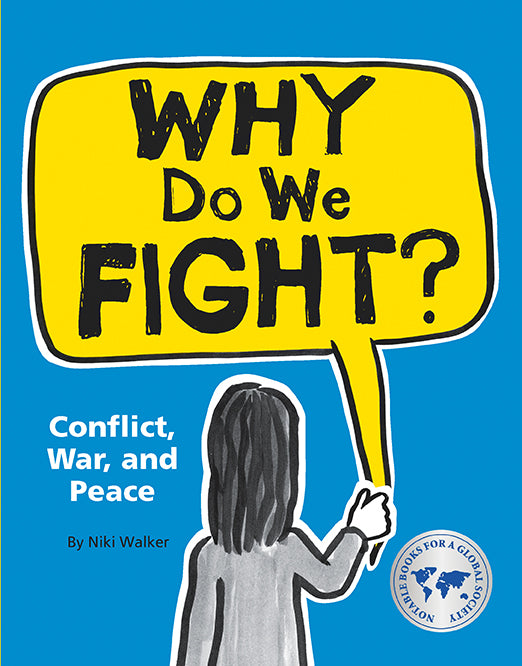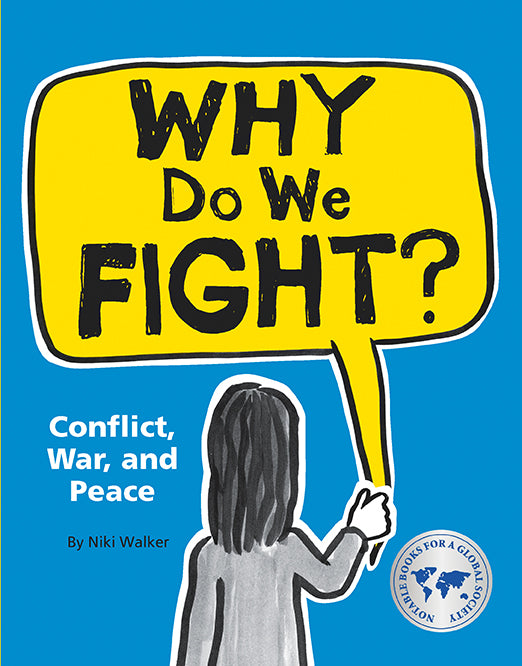Why Do We Fight?
Niki Walker
Since it's impossible for people to agree on everything all the time, conflicts naturally pop up every day, all over the world. Sometimes they turn into full-blown wars, which can be a lot trickier to understand than the conflicts that pop up in everyday life, but every conflict has some things in common.
Using real world examples, Why Do We Fight? teaches kids to recognize the structures, factors, and complex histories that go into creating conflicts, whether personal or global — as well as the similarities between both. They'll be given tools to seek out information, enabling them to make informed opinions while learning to respect that others may form different ones.
From culture clashes and trade disputes to disagreements about how to govern, Why Do We Fight? insists that the key to fulfilling humankind's wish for "world peace" lies in how we choose to deal with conflict and provides a genuine cause for optimism in the face of an at-times frightening world.
Niki Walker
Couldn't load pickup availability
SKU: 205971n0nn1nWWW | ISBN: 9781771473545
[An] exemplary study of the reasons disagreements arise and how they can be addressed. - Publishers Weekly, STARRED REVIEW
Walker offers clear, concise explanations of power and resource inequities, cultural divisions, the global role of the United Nations, bias, prejudice, and more...[she] gives readers the tools to understand anda analyze the kinds of clashes, wars, and disagreements that they regularly hear about in the news. - Publishers Weekly
Walker does an excellent job of breaking down the basics of conflict...[this] will have a longer shelf life than other informational texts as it won't go out of date quickly. Teachers could build seminars and lessons around each chapters, and interested students will find much to think about. - School Library Journal
an important source for children expressing an early interest in politics and social justice. - ForeWord Reviews
"A useful tool for the classroom teacher, Why Do We Fight? will not only provide a springboard for lively group discussions, but it will also help middle school students to examine conflicts from several perspectives."
- CM Magazine
"Valuable for its nonjudgmental tone, this is also a rich resource for conflict-related terms." - School Library Monthly
"An engaging and accessible overview to peace and conflict studies. ... It would be a welcome addition to school libraries, middle school classrooms, and home collections." - International Journal on World Peace
brilliantly takes the complicated subject of war and breaks it down in an unbiased, sensible, easy to understand manner ... I have yet to see any other book like this. - What They Don't Teach You in School You'll Learn Here
Ontario Library Association Red Maple (Non-Fiction) Award, 2015
IRA Notable Book for a Global Society, 2014
OLA Best Bets Top 10 Junior Non-Fiction List, 2013
Cybils Awards, Elementary/Middle-Grade Nonfiction category, 2013
ForeWord Magazine Book of the Year Award, Juvenile Non-fiction category, 2013
Bank Street College of Education's list of Best Children's Books of 2013 (for ages 9-12), 2013
Canadian Children's Book Centre Best Books for Kids and Teens, 2014
One of New York Public Library's "10 Nonfiction Titles You May Have Missed: Fall 2013 (YA)", 2013

Publication date
March 15, 2019
Number of pages
80
Curriculum
Social Studies
Lexile® Level
AD590L
Interest age
From 10 to 14

